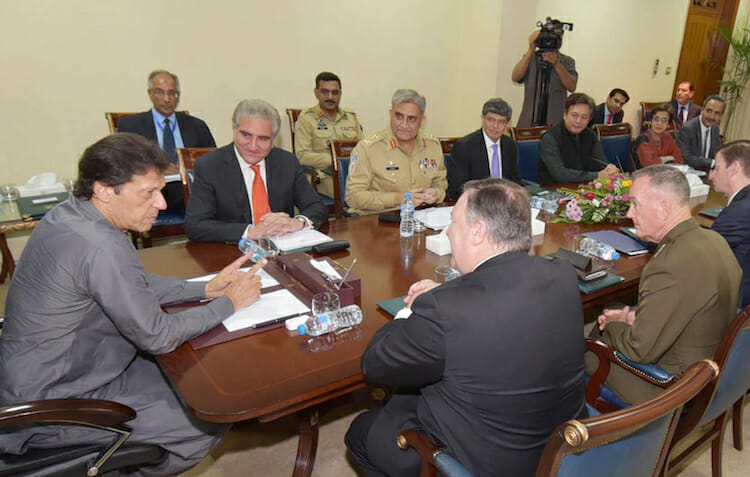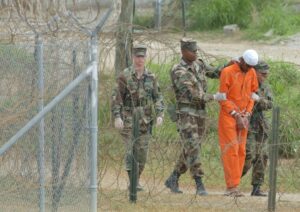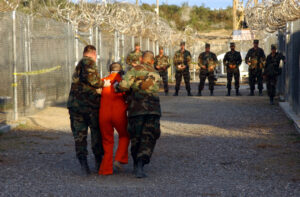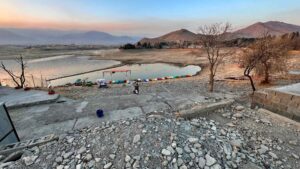Pompeo’s Five Hours in Islamabad
A U.S. “reset” of relations with Pakistan seems like a long shot in light of recent history and the Trump administration’s moves on the global stage. Pakistan's Prime Minister Imran Khan, left, meets visiting U.S. Secretary of State Mike Pompeo, front, in Islamabad, Pakistan, on Wednesday. (Pakistan Press Information Department via AP)
Pakistan's Prime Minister Imran Khan, left, meets visiting U.S. Secretary of State Mike Pompeo, front, in Islamabad, Pakistan, on Wednesday. (Pakistan Press Information Department via AP)
KARACHI, PAKISTAN — He came, he talked briefly and he left. All in one afternoon. That sums up U.S. Secretary of State Mike Pompeo’s fleeting visit to Islamabad on Sept 5. Since expectations were not high, both sides opted to be discreet about disclosing what they had discussed. No doubt they were courteous and conciliatory. That would have helped to create the atmosphere needed to “reset” relations between the U.S. and Pakistan, the main purpose of this exercise in diplomacy.
“The ice has been thawed,” remarked Pakistan’s Foreign Minister Shah Mehmood Qureshi. Secretary Pompeo reciprocated the positivity, saying he was hopeful that the foundation had been laid for “continued success.”
It is too early to say what direction this resetting will take. Given the confrontational tone that marked ties between the two countries on the eve of Pompeo’s visit, there was widespread relief that the outcome was free of acrimony—especially on social media, in keeping with the U.S. president’s style of conducting foreign policy, which pre-empts quiet negotiations.
Various incidents in the last week or so were seen as foreshadowing. It would have been a wonder had Pompeo managed to produce a turnaround.
A few days after Pakistan’s new prime minister, Imran Khan, was sworn in, Pompeo made a goodwill call. During their conversation, he let Khan know that the issue of terrorism would also be on the agenda when he arrived for talks in Pakistan. This was a red flag to Pakistan, which has constantly denied giving safe haven to the Taliban, who have been trying to topple the government in Afghanistan. After a spat over the content of that phone conversation as recorded in the readout issued by the State Department, Islamabad chose to let the matter die.
Soon thereafter came the announcement from Washington of the “reallocation” of military aid of $300 million originally earmarked to Pakistan for the Coalition Support Fund. Pompeo explained it away as a predictable move, since Pakistan was not keeping up its side of the deal by producing the expected results.
Although U.S.-Pakistan relations have gone through rough patches in the past, they have never sunk quite this low. The onset of the Trump presidency marked the beginning of this slide. Washington’s stance hardened visibly in August 2017 when Trump announced a new South Asia policy that spelled out a shift toward India while demanding that Pakistan do more. The last straw came with Trump’s New Year’s tweet in January, accusing Pakistan of “deceit and lies.”
A few revealing remarks by Pompeo in Islamabad, however, give an idea of the overall message he conveyed during this visit. “We made it clear to them—and they agreed—it is time for us to begin to deliver on our joint commitments.” Some main points of agreement, as they emerged from the press statements of the two sides, were:
● Agreements previously made were not actually executed;
● The need is to act to deliver outcomes to build trust and confidence between the two countries;
● Military relations would be leveraged to support the agreement between the prime sinister and the secretary of state, and boost President Trump’s South Asia strategy;
● Military ties would be one of the props to take the rapprochement forward.
Both sides conceded that challenges continue to exist, but these were not spelled out.
It is clear that the U.S. continues to look at Pakistan through the Afghan prism. Washington is seeking to pull out of Afghanistan at the earliest time, but only after a stable pro-U.S. government is firmly in place in Kabul. Can the use of military power achieve this goal? Pakistan is suspected of protecting the Taliban, which don’t wish to see President Ashraf Ghani at the helm.
It is widely known that Pakistan’s army created the Taliban as its “strategic asset.” But what is not known is if the patron still controls the protégé. Like Frankenstein’s monster, are Taliban officials no longer taking orders from their progenitors?
For Pakistan these are not easy times. Decades of dependence on foreign assistance has robbed it of its self-reliance. The nation’s foreign debt has escalated to unbelievable levels. Pakistan is now on the brink of defaulting on its debt service and needs a bailout. The International Monetary Fund can help, but the U.S. has threatened to block it; Washington is adamant that it cannot allow the IMF to make payments that will be channeled into repaying Chinese loans. And China is anathema to the U.S.
Pompeo stated clearly that he wanted to meet with Pakistan’s new leadership at the start of its tenure. It is true that Khan’s administration doesn’t carry the baggage of the history of U.S.-Pakistan relations, although the Pakistan Tehreek-e-Insaf (PTI) leader adopted an anti-American stance in his election campaign.
However, the military has always played a key role in Pakistan’s politics and foreign policy, and is believed to have facilitated the ascendancy of the PTI in politics.
Pakistan’s army chief, Gen. Qamar Javed Bajwa, participated in the talks with Pompeo and, according to Foreign Minister Qureshi, the civilian and military leaders were on the same page.
The challenges Qureshi and Pompeo face include Pakistan’s ties with China and India. Pakistan’s friendship with Beijing—described as being as high as the Himalayas and as deep as the Indian Ocean—has made it an integral part of China’s global ambition in the One Road-One Belt project. Underpinned by a massive $55 billion Chinese loan, this venture has brought immediate gains to Pakistan, but there is skepticism about the economic trap it is expected to lay for Pakistan in the long term. And the United States’ reservations about China are well-known.
The challenge stemming from Pakistan’s ties with India is no less serious. For the last decade, relations between the two countries have been deadlocked. The on-again-off-again dialogue that was launched in the 1990s stands suspended. Trump now wants India to be a key partner in South Asia. How acceptable would that be for Islamabad?
Ever since Pakistan became a “special ally” of the U.S. in the 1950s, all American administrations have tried to be even-handed in dealings with the two South Asian neighbors. Since 1998, when the two countries became nuclear powers, the U.S. had an added reason to treat its ties with the two countries with discretion.
Trump has flouted this self-made guiding principle of the United States’ South Asian policy. As a reminder of this “challenge,” Qureshi said in a press conference that the U.S. has been asked to play its role in the improvement of India-Pakistan relations—especially the situation on the Line of Control in Kashmir, so that the focus on the western border with Afghanistan could be intensified. And Kashmir is India’s Achilles heel.
Your support matters…Independent journalism is under threat and overshadowed by heavily funded mainstream media.
You can help level the playing field. Become a member.
Your tax-deductible contribution keeps us digging beneath the headlines to give you thought-provoking, investigative reporting and analysis that unearths what's really happening- without compromise.
Give today to support our courageous, independent journalists.






You need to be a supporter to comment.
There are currently no responses to this article.
Be the first to respond.